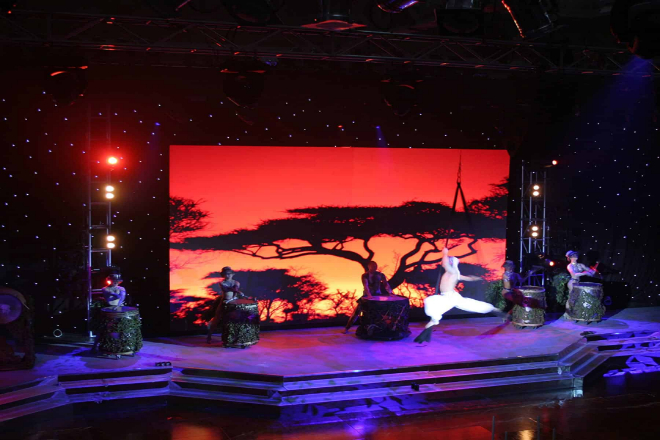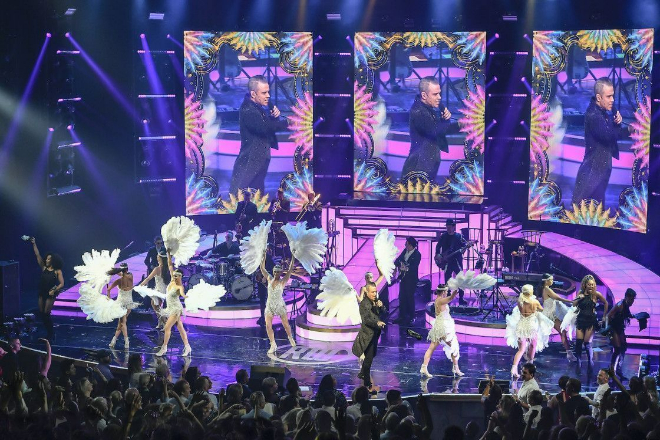Introduction

Bien que les formes traditionnelles de représentation scénique des théâtres soient classiques et charmantes, elles présentent certaines limites dans la présentation des effets visuels et la flexibilité de la conception scénique.
L'émergence de écrans LED d'intérieur a révolutionné le monde du cinéma. Cet article évoque la valeur que les écrans LED d'intérieur peuvent apporter aux cinémas.
1. Présentation des caractéristiques techniques des écrans LED d'intérieur
1). Haute résolution et reproduction des couleurs
1.1). Haute-résolution caractéristiques:
Les écrans LED d'intérieur sont connus pour leur résolution extrêmement élevée, ce qui signifie que les pixels de l'écran sont densément emballés et capables d'afficher des images plus détaillées et plus claires.
La haute résolution améliore non seulement l'expression des détails de l'image, mais rend également les bords des éléments tels que le texte et les motifs plus lisses et sans bords irréguliers, offrant ainsi une expérience visuelle plus réaliste au public.
1.2). Capacité de reproduction précise des couleurs :
Les écrans LED utilisent des billes de lampe LED avancées comme éléments émetteurs de lumière, qui ont une large gamme de couleurs et des performances de couleur très cohérentes.
Grâce à un système de gestion des couleurs précis, les écrans LED peuvent reproduire avec précision une variété de couleurs, qu'il s'agisse de rouge vif, de vert, de bleu ou de dégradés subtils, et elles peuvent toutes être parfaitement présentées.
Cette excellente capacité de reproduction des couleurs rend les images sur scène plus vives et plus réalistes, améliorant ainsi l’expression artistique.
1.3). Améliorer le réalisme et l'expression artistique de organiser effets visuels:
Les caractéristiques techniques de haute résolution et de reproduction précise des couleurs améliorent conjointement le réalisme et l'expression artistique des effets visuels de la scène.
Qu'il s'agisse d'un théâtre, d'un concert ou d'un spectacle de danse, l'écran LED peut présenter l'arrière-plan de la scène, les effets spéciaux et d'autres éléments avec les couleurs les plus réalistes et les images les plus délicates, créant une expérience visuelle plus immersive pour le public.
Dans le même temps, les artistes peuvent également utiliser ces caractéristiques techniques pour créer des scénographies plus colorées et plus créatives et améliorer la valeur artistique des performances.
2). Flexibilité et personnalisation
2.1). Personnalisé en fonction des besoins réels de la scène du théâtre :
Les écrans d'affichage LED d'intérieur sont extrêmement flexibles et peuvent être personnalisés en fonction des besoins réels de la scène du théâtre. Qu'il s'agisse de la taille, de la forme ou de la méthode d'installation, ils peuvent être ajustés en fonction des exigences de conception de la scène.
Par exemple, il peut être fabriqué dans des formes spéciales telles qu'un arc et des formes spéciales pour s'adapter à la disposition et au style de différentes scènes ; la méthode d'installation peut également choisir parmi une variété de méthodes telles que la suspension, la suspension murale, l'incrustation au sol, etc. pour répondre aux besoins de différentes scènes.
2.2). Offrir aux théâtres des possibilités de scénographie plus diversifiées :
Cette flexibilité offre au théâtre des possibilités de conception de scène plus variées. Les concepteurs peuvent laisser libre cours à leur imagination et utiliser des écrans d'affichage LED pour créer divers effets scéniques uniques.
Qu'il s'agisse de simuler des paysages naturels et urbains ou d'afficher de l'art abstrait et des technologies futures, les écrans d'affichage LED peuvent les présenter parfaitement, ajoutant un charme infini aux performances scéniques.
3). Luminosité et réglage du contraste
3.1). Plage de réglage de la luminosité :
La luminosité des écrans LED d'intérieur peut être réglée sur une large plage et en temps réel en fonction des différents environnements d'éclairage. Dans les environnements à faible luminosité, la luminosité peut être réduite pour éviter l'éblouissement.
Dans les environnements plus lumineux, la luminosité peut être augmentée pour garantir que l'image soit clairement visible. Cette fonction de réglage de la luminosité permet à l'écran LED de maintenir des effets visuels optimaux dans diverses conditions d'éclairage.
3.2). La fonction de réglage du contraste améliore la superposition et la tridimensionnalité de l'image de scène :
En plus du réglage de la luminosité, l'écran LED dispose également d'une fonction de réglage du contraste. En réglant le contraste clair et sombre de l'image, la superposition et le sens tridimensionnel de l'image de la scène peuvent être améliorés.
Les détails dans les zones sombres sont plus clairement visibles et les zones claires sont plus distinctes et plus proéminentes, ce qui rend l'image entière plus vivante et texturée. Cette fonction de réglage du contraste joue un rôle important dans l'amélioration des effets visuels et de l'expression artistique des images de scène.
2. Valeur d'application de l'affichage LED intérieur dans le théâtre

1) Améliorer l'effet artistique de la scène
L'écran d'affichage LED d'intérieur, avec ses images haute définition et ses effets dynamiques, a apporté un saut qualitatif dans les effets artistiques de la scène du théâtre. Les écrans d'affichage LED peuvent présenter une qualité d'image délicate et réaliste avec des couleurs vives et un contraste élevé, apportant un fort impact visuel au public.
Dans le même temps, en diffusant des arrière-plans dynamiques, des effets spéciaux et des animations étroitement liés au contenu de la performance, l'affichage LED peut grandement améliorer l'attrait et l'expressivité de la performance sur scène.
Par exemple, lors d'une représentation théâtrale, l'affichage LED peut créer une atmosphère de scène réaliste, donnant au public l'impression d'être au cœur de l'intrigue ; lors d'un concert, l'affichage LED peut correspondre au rythme et à la mélodie de la musique pour présenter un effet visuel éblouissant. Améliorez l'atmosphère générale de la représentation.
Exemples d'application :
- Représentations théâtrales :
Lors de la représentation de la pièce « Salon de thé », des écrans LED ont été utilisés pour créer l’atmosphère d’un ancien salon de thé de Pékin.
En diffusant des images de scènes de rue du vieux Pékin et de l’ameublement intérieur des salons de thé, le public semblait voyager dans cette époque et avait une compréhension plus profonde de l’intrigue et du destin des personnages.
- Spectacle de danse :
Dans la représentation de danse « Guanyin aux mille bras », des écrans d’affichage LED ont été utilisés pour créer une atmosphère mystérieuse et solennelle.
En jouant des effets et des motifs de lumière et d'ombre en constante évolution, l'écran d'affichage LED complète parfaitement la performance de danse, offrant une expérience visuelle choquante au public.
2). Enrichir la performance scénique
Les écrans LED d'intérieur apportent une nouvelle forme d'expression à la scène du théâtre. En diffusant des scènes virtuelles, des effets 3D, des animations et d'autres contenus multimédias, les écrans LED ont brisé les limites des décors scéniques traditionnels et ont offert au public des effets visuels plus riches et plus variés.
Par exemple, dans un drame de science-fiction, l’affichage LED peut créer une atmosphère de scène du monde futur, donnant au public l’impression d’être dans un film de science-fiction.
Lors d'un spectacle de danse, l'affichage LED peut présenter une scène qui fait écho aux mouvements de la danse. Les effets de lumière et d'ombre renforcent l'expression artistique de la scène.
Ces nouvelles formes scéniques ouvrent de nouvelles possibilités de représentation au théâtre. Les théâtres ne sont plus limités par les contraintes des décors scéniques traditionnels et peuvent s'essayer à des types et styles de représentation plus variés.
Dans le même temps, ces nouvelles formes d’expression ont également attiré davantage l’attention et l’amour du public.
Par exemple, en diffusant des séquences de jeux interactifs avec le public ou des commentaires en temps réel sur les réseaux sociaux, l’écran d’affichage LED améliore l’interactivité et le plaisir de la performance et attire davantage de jeunes publics à participer.
3) Améliorer l'efficacité et la flexibilité des performances
L’utilisation d’écrans LED intérieurs simplifie grandement le processus de changement de décor de scène.
Comparés aux configurations de scène traditionnelles qui nécessitent beaucoup de main-d'œuvre, de ressources matérielles et de temps pour être remplacés et organisés, les écrans d'affichage LED peuvent basculer entre différentes scènes simplement en modifiant le contenu de lecture et les images.
Cela réduit non seulement considérablement le temps de préparation de la représentation, mais également le coût de la représentation.
Les écrans LED sont également très performants pour répondre aux besoins de performances temporaires ou pour ajuster le contenu des performances. Étant donné que la lecture du contenu de l'écran LED s'effectue via des signaux numériques, il peut être mis à jour et modifié en temps réel.
Cela signifie que le théâtre peut rapidement ajuster le contenu de la représentation ou répondre à des besoins temporaires de représentation dans un court laps de temps, améliorant ainsi la flexibilité et l'adaptabilité de la représentation.
4) Améliorer l'expérience du public
L'écran d'affichage LED d'intérieur offre une expérience visuelle plus immersive au public.
En diffusant des arrière-plans dynamiques, des effets spéciaux et des animations étroitement liés au contenu de la performance, l'affichage LED donne au public l'impression d'être au cœur de l'intrigue et d'avoir un lien émotionnel plus étroit avec les personnages.
Cette expérience visuelle immersive améliore non seulement le plaisir visuel du public, mais renforce également l’attrait artistique de la performance.
Les écrans LED sont également excellents pour augmenter l'engagement du public. En jouant sur des écrans de jeu interactifs ou en commentant en temps réel sur les réseaux sociaux, l'écran LED améliore l'interactivité et le plaisir de la performance, permettant au public de participer plus activement à la performance.
Dans le même temps, en diffusant des images émotionnelles et des effets sonores correspondant à l'intrigue, l'affichage LED peut également stimuler la résonance émotionnelle du public, permettant au public de comprendre et de ressentir plus profondément le thème et la connotation de la performance.
Par exemple, lors d'une représentation théâtrale, l'écran LED peut diffuser des images émotionnelles et des effets sonores qui correspondent à l'intrigue, permettant au public de comprendre et de ressentir plus profondément le monde intérieur et les changements émotionnels du personnage.
3. Défis et solutions pour les écrans LED d'intérieur dans les cinémas

1) Défis techniques
Dans les applications théâtrales, les problèmes techniques que peuvent rencontrer les écrans LED incluent, sans s'y limiter, une luminosité excessive, une distorsion des couleurs, un scintillement de l'écran, des limitations d'angle de vision et des problèmes de dissipation thermique.
Par exemple, une luminosité excessive peut provoquer une fatigue visuelle chez le public et même affecter les performances des acteurs ; la distorsion des couleurs réduira considérablement les effets de scène et ne parviendra pas à transmettre avec précision l'atmosphère et les émotions de la représentation.
De plus, le scintillement de l'écran et les limitations de l'angle de vision affecteront également l'expérience visuelle du public, tandis que les problèmes de dissipation thermique peuvent affecter la durée de vie et la stabilité de l'écran LED.
1.1). Solutions et améliorations techniques :
- Réglage de la luminosité :
Pour résoudre le problème de luminosité excessive, vous pouvez régler la luminosité de l'écran d'affichage LED de manière flexible en fonction des exigences de performance et de la position du public pour garantir que le public apprécie la performance dans une plage visuelle confortable.
- Correction des couleurs :
Effectuez régulièrement une correction des couleurs à l'aide d'un équipement et de méthodes de correction des couleurs professionnels pour garantir que la couleur de l'écran LED est précise, lumineuse et non déformée.
- Optimiser la qualité de l'image :
Utilisez des perles de lampe LED et des puces de pilote de haute qualité pour améliorer le taux de rafraîchissement et le contraste de l'image et réduire le scintillement de l'écran. Dans le même temps, la conception de l'angle de vision de l'écran d'affichage est optimisée pour garantir que les spectateurs peuvent voir des images claires et complètes à différentes positions.
- Gestion de la dissipation thermique :
Renforcez la conception de dissipation thermique de l'écran LED, par exemple en utilisant des ventilateurs de refroidissement, des dissipateurs thermiques et d'autres dispositifs de dissipation thermique pour garantir que l'écran maintient la stabilité et la fiabilité en fonctionnement à long terme.
2). Considérations relatives aux coûts
Le coût d’investissement initial des écrans d’affichage LED est relativement élevé, comprenant principalement les coûts de l’écran, les coûts du système de contrôle, les coûts d’installation, etc.
Les prix des écrans LED de différents modèles et spécifications varient considérablement, et les cinémas doivent choisir en fonction de leurs propres besoins et budgets. Les coûts de maintenance ultérieurs comprennent les frais d'électricité, les coûts de réparation, les coûts de mise à jour et de mise à niveau, etc.
À mesure que la durée d'utilisation augmente, les écrans d'affichage LED peuvent rencontrer des problèmes tels que le vieillissement des billes de lampe et la défaillance de la puce du pilote, nécessitant une réparation et un remplacement.
2.1). Stratégies visant à réduire les coûts globaux d’exploitation du théâtre :
Planification raisonnable : lors de l'achat d'écrans LED, les cinémas doivent établir des plans raisonnables en fonction des besoins réels et du budget. Choisissez des modèles et des spécifications adaptés à la taille du cinéma et aux besoins de performance pour éviter le gaspillage causé par un surinvestissement.
- Gestion intelligente :
Utilisez un système de gestion intelligent pour surveiller et gérer à distance les écrans LED, détecter et résoudre les pannes potentielles en temps opportun et réduire les coûts de maintenance. Dans le même temps, les factures d'électricité peuvent être réduites grâce à une planification intelligente et à des stratégies de lecture d'images optimisées.
- Entretien régulier :
Élaborez un plan de maintenance régulier pour nettoyer, inspecter et entretenir l'écran LED. Détectez et gérez les problèmes potentiels en temps opportun pour prolonger la durée de vie et la stabilité de l'écran.
- Coopération et partage :
Coopérer avec d'autres théâtres ou groupes de spectacles pour partager les ressources d'affichage LED. Réduire les coûts d'investissement et de maintenance d'un seul théâtre grâce à des représentations coopératives ou à la location. Dans le même temps, il peut également favoriser les échanges et la coopération entre les théâtres et promouvoir conjointement le développement du marché du spectacle.
Conclusion
En résumé, la valeur d'application des écrans d'affichage LED d'intérieur dans les théâtres est évidente. Non seulement ils améliorent considérablement les effets artistiques et les formes de performance de la scène, rendant les performances plus vivantes, réalistes et contagieuses, mais ils améliorent également considérablement l'efficacité et la flexibilité des performances, offrant un soutien solide au théâtre pour faire face aux divers besoins de performance.
Enfin, si vous souhaitez en savoir plus sur les écrans LED, veuillez nous contacter.
